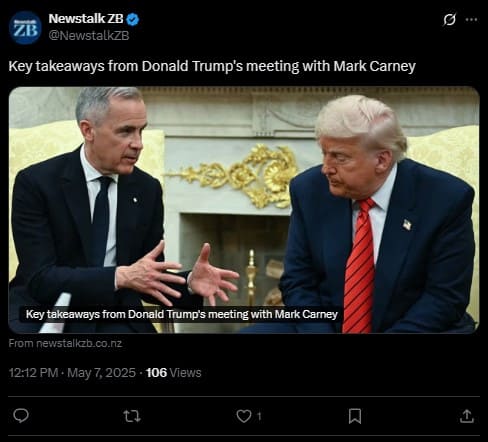In a pivotal meeting at the White House on May 6, 2025, U.S. President Donald Trump and newly elected Canadian Prime Minister Mark Carney confronted escalating tensions over trade policies and national sovereignty.
The encounter, while outwardly cordial, underscored deep-seated disagreements that could shape the future of U.S.-Canada relations.
1. Carney Firmly Rejects Annexation Proposal
President Trump reignited controversy by suggesting Canada become the 51st U.S. state, a notion he has floated previously. Prime Minister Carney responded decisively, stating, “Canada is not for sale.
It won’t be for sale, ever,” drawing parallels to iconic landmarks like Buckingham Palace to emphasize Canada’s sovereignty . Trump, undeterred, replied, “Never say never,” highlighting the ongoing friction over national identity.
2. Stalemate on Tariff Disputes
Trade tensions dominated the discussion, with President Trump maintaining a firm stance on existing tariffs, including a 25% levy on Canadian steel, aluminum, and automotive imports. He dismissed the possibility of lifting these tariffs, stating, “Just the way it is”.
Prime Minister Carney criticized the tariffs as detrimental to both economies and advocated for revisiting aspects of the U.S.-Mexico-Canada Agreement (USMCA) to address perceived imbalances.
3. Diplomatic Tone Amidst Underlying Tensions
Despite the contentious issues, the meeting maintained a veneer of diplomacy. Both leaders exchanged compliments, with Trump acknowledging Carney’s recent electoral victory and Carney expressing a willingness to engage in constructive dialogue.
However, the underlying tensions were evident, particularly regarding trade policies and sovereignty concerns.
4. Carney’s Ascendancy Bolstered by Anti-Trump Sentiment
Prime Minister Carney’s recent electoral success was significantly influenced by his opposition to President Trump’s policies, particularly the proposed annexation and trade tariffs.
His firm stance during the campaign resonated with Canadian voters, leading to a decisive victory for his Liberal Party.
5. Future Engagements and Ongoing Negotiations
Both leaders agreed to continue discussions, with plans to meet again at the upcoming G7 summit in Canada. While no immediate resolutions were achieved, the commitment to ongoing dialogue suggests a mutual interest in addressing the complex issues affecting bilateral relations.
The meeting between President Trump and Prime Minister Carney highlighted the challenges facing U.S.-Canada relations, marked by disputes over trade and national sovereignty.
While the leaders maintained a diplomatic front, the substantive disagreements underscore the need for continued engagement to navigate the evolving dynamics between the two nations.
